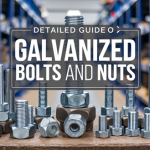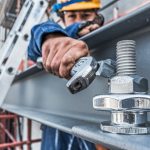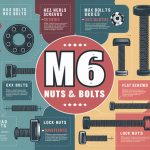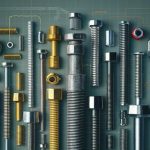Introduction

The square head bolt has come a long way since its modest start in the early days of industrial manufacturing. From its practical origins as an easy fastening solution to its modern precision-engineered component, the square head bolt has experienced a remarkable change. It has adapted to the ever-changing demands of industry and revolution. Today we embark upon a journey into the fascinating evolution of square head bolts; those unrecognized tools responsible for holding our world together!
History of Square Head Bolts
In the 19th century, square head bolts appeared as an answer to the limits of traditional hexagonal head bolts. They were likely to slide and shedding under heavy loads. Originally, square head bolts were used in the building of infrastructure, such as bridges. Here the square shape gave a solid foundation for anchoring and holding heavy loads in place.
In 1905, the USA was home to more than six hundred firms that focussed in the manufacturing of nuts and bolts. The extensive use of newly industrialized bolt designs was a significant factor that contributed to the huge demand for bolts in the 19th century in many countries.
In the 20th century, new materials like stainless steel as well as titanium were introduced. It additionally amended the workings of square head bolts in industrial applications. Throughout the years, square head bolts have adapted to the changing requirements of the business
Some of the other new bolt configurations that occurred over the next thirty-year period included:
- Star Bolt: The star bolt was made to offer a more secure fastening method, resistant to altering and damage.
- Bastard Neck Bolt: The bastard neck configuration had a thin bolt head and a short rectangular shaft.
- Fin-Head Bolt: This bolt was designed with thin tows beneath the head that helped keep it steady while a nut was being tightened or detached.
Application of Square Head Bolts in Early Industry
In the early days of industrial manufacturing, square head bolts were not as extensively used as they are today. Today, the evolution of square head bolts has a rich history that spans over a century, from classic craftsmanship to modern marvels.
1. Classic Craftsmanship
Square head bolts have their origins in traditional artistry, dating back to the early days of bolt manufacturing. They were originally made from square iron bars, which were cut, heated, and formed into bolts.
2. Industrial Revolution:
The Industrial Revolution, in the 18th century, gave a significant twisting point in the history of square head bolts. The new manufacturing machinery, such as the Bessemer procedure, allowed the production of high-quality steel square head bolts in a variety of sectors.
Other manufacturing techniques and machinery allowed mass production, making square head bolts more broadly accessible and inexpensive.
3. Railroad Industry
Square head bolts found widespread use in the railroad industry, mostly in the development of railroad tracks. Their square shape made them perfect for use in tighter spaces, and the high torque made them the best choice for heavy-duty apps.
READ ALSO: BUILDING STRONG FOUNDATIONS: THE POWER OF CARRIAGE BOLTS
4. Modern Industry
At present, square head bolts are made from high-strength materials and are made for specific applications. They are used in plentiful industries, such as construction, manufacturing, and engineering. Modern manufacturing preparations have also made them more well-organized and cost-effective.
5. Applications Beyond Wood and Metal
As square heads expanded their applications beyond wood and metal, new opportunities were presented. Besides wood and metal Square head bolts are used in plastic and composite materials, aircraft and spacecraft applications where high strength and reliability are critical. Square head bolts are also used in sports equipment, in artistic applications, such as sculpture, installation art, and public art installations and so on.
6. Bolts in the Digital Era:
Squareheads have become indispensable components in our increasingly technological world. Bolts in the digital era have undergone noteworthy transformations, driven by technological advancements and cumulative demand. Today it gives effectiveness, accuracy, and connectivity. Some key developments include:
- 3D Printing
- CNC machines
- Automation and Robotics
- Medical equipment
- Chemicals and Materials
The Future of Square Heads
But our journey doesn’t end here! As technology rapidly develops, square heads stand poised to flourish even more rapidly. As we look to the future, it is clear that the Development of Square Head Bolts will continue to play a vital role in determining the world around us. It is driving growth and innovation and is an essential part of the machinery that keeps our modern world functioning.
FAQs:
1. Do square head bolts hold well than round-head bolts?
It depends! Square heads typically provide greater gripping power due to their larger surface area, making them perfect for heavy-duty applications such as construction. Meanwhile, round heads may be easier for tight spaces and lighter materials – pick the type that meets the requirements of your project!
2. Is it permissible to paint or decorate my bolts?
Absolutely! As long as it doesn’t compromise their function or strength, go wild with creativity! Using paint, stencils or tape makes them fun to look at while being functional tools!
3. Where do people typically use bolts?
Historically, people have found bolts everywhere, from buildings and ships to construction site equipment like screws. From bridges and furniture to cars, and spaceships – bolts connect everything that needs connecting!
4. Is It Right to Reuse Old Bolts?
Repurpose old bolts as hanging hooks, tool organizers or furniture accents without fear of them becoming rusted or damaged – upcycling is awesome!
5. Can I tighten a bolt without using a wrench?
Inventiveness may be your answer! Use temporary holds like pliers or use unconventional levers like chopsticks and spoons (with caution!).
6. What safety tips should I keep in mind with bolts?
Always wear protective eyewear and gloves when working with metal and be wary of sharp edges; securely fasten heavy objects without over-tightening to reduce breakage risks.
7. Where can I find inspiration for bolt projects?
The internet provides endless sources for inspiration when it comes to bolt projects! Pinterest, DIY blogs and hardware stores all provide ideas ranging from rustic benches to industrial shelves.
8. What factors should you consider when buying bolts?
Match a bolt to your needs! Take into consideration weight, material composition, available space requirements and strength specifications as well as head type and thread size considerations when searching for the appropriate bolt.
9. Can you combine bolts?
Absolutely. Square and round heads work seamlessly together! Use them for additional stability or use their unique qualities for different projects according to their strengths – teamwork makes DIY dreams possible!
Read Also:
> Built to Withstand the Storm: Why High Tensile Fasteners are the Unsung Heroes of Construction
> Fasten Your Seatbelts! High Tensile Fasteners Are Here! – Innovation and Sustainability

